Dark Years — Armenia in the early 90s
Categories: History
By Pictolic https://pictolic.com/article/dark-years-armenia-in-the-early-90s.htmlThere have been different epochs in the history of Armenia, but one of them stands apart. Despite its short duration by historical standards — 3-4 years, it left such a deep mark that the life of several generations of Armenians was divided into "before" and "after". The years from 1992 to 1995 are called differently - "hungry", "cold", "bad". But the most common and comprehensive name is "dark"…
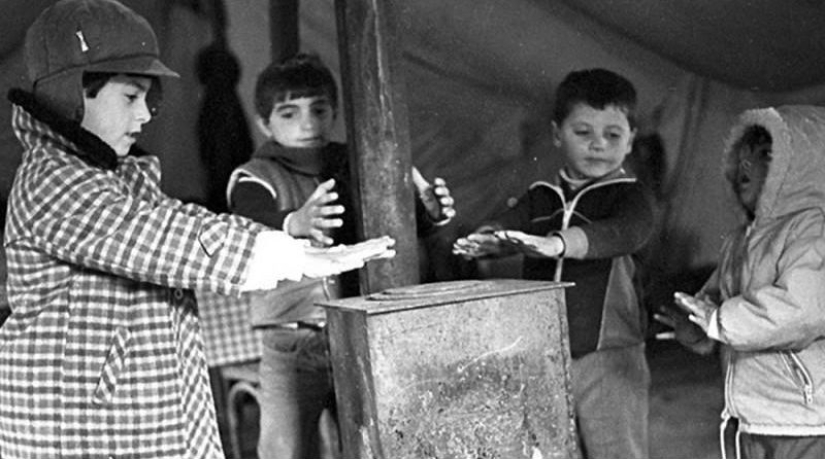
Say this phrase "dark years" in the presence of any Yerevan resident, and you will see how the smile disappears for a moment and a gloomy shadow runs across your face. And there is why. In these few years — from 1992 to 1995 - Armenia experienced an unnoticed apocalypse on the scale of a single small country, the agony in which it parted with its previous life. But then it seemed — with life in general…
When natural gas stopped flowing to Armenia in the summer of 1991, few people thought that this household problem was only the first link in the chain of the most severe shocks awaiting the entire nation. The statements of individuals that the electricity would soon be turned off were perceived with bewilderment and slight irony. I just couldn't believe it, they laughed and made fun of the "alarmists". But the events unfolded much worse than could have been assumed. The collapsed Soviet Union buried under its rubble economic and transport links, a single energy network. Due to the war in Nagorno-Karabakh, Armenia was in a state of complete blockade. Transit gas supply to the country was blocked from Azerbaijan, railways froze — goods traveling through Azerbaijani territory simply did not reach Armenia.
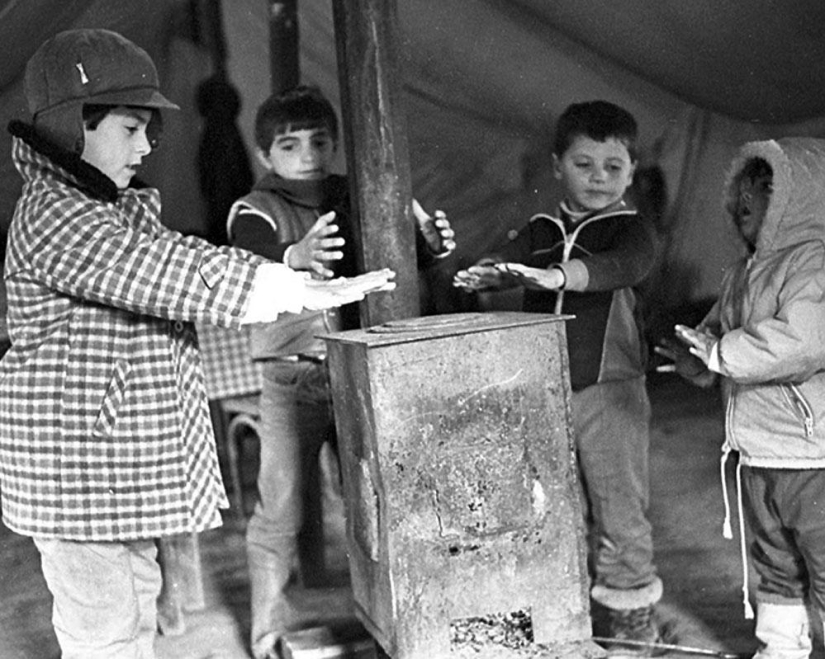
Say this phrase in the presence of any Yerevan resident — "dark years", and you will see how the smile disappears for a moment and a gloomy shadow runs across your face. And there is why. In these few years — from 1992 to 1995 - Armenia experienced an unnoticed apocalypse on the scale of a single small country, the agony in which it parted with its previous life. But then it seemed — with life in general…
From the south, Turkey officially declared the blockade of Armenia, closing the border and blocking all land and air traffic. Conflicts in Abkhazia and Ossetians also made it impossible to communicate with Russia through Georgia. The only transport thread — the road to the Georgian port of Poti — physically could not provide Armenia with everything necessary. The supply of food and, most importantly, grain and flour stopped. Almost everything has stopped coming — from matches and soap to raw materials and energy carriers. The Armenian nuclear power plant has been shut down since 1990, while Armenia's thermal power plants have lost fuel oil and gas. And if there is no fuel oil and gas, the boiler rooms will not be able to work either. An energy catastrophe has become inevitable.
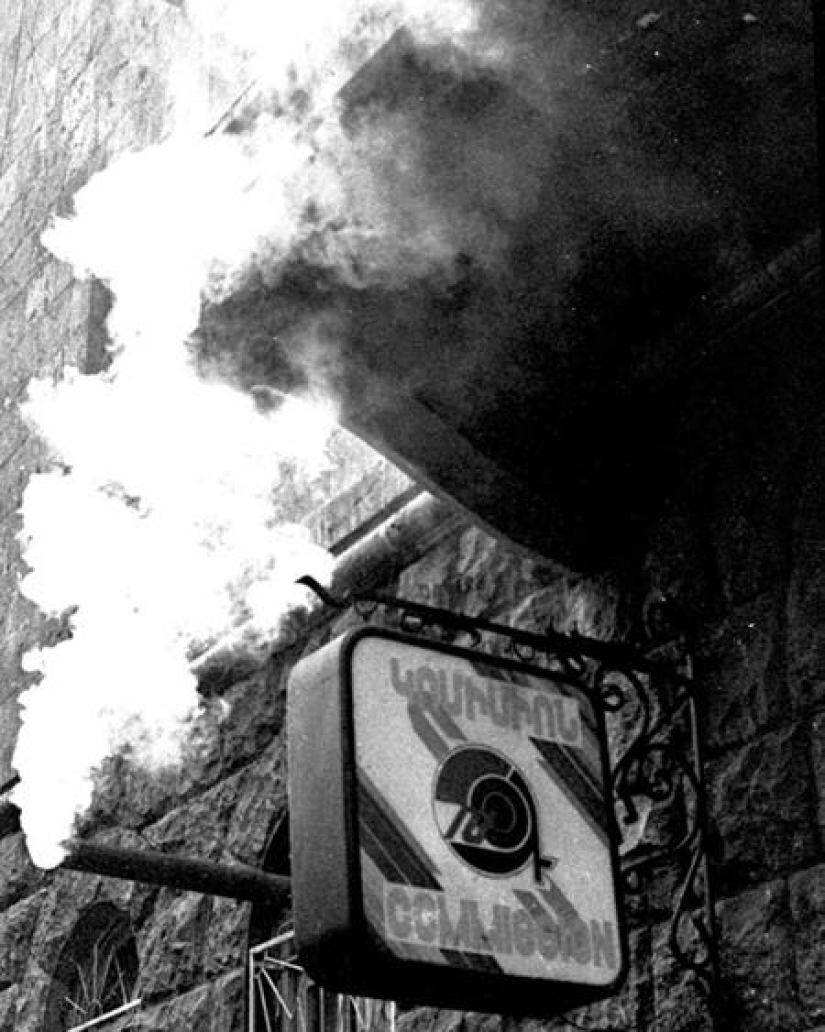
Since January 1992, daily "rolling blackouts" of electricity have begun in Armenia. At first they were turned off for a couple of hours, then this interval began to increase inexorably — 6 hours, 9, 12, 18 ... By November it was officially announced that electricity would be supplied to the apartments for only 1 hour a day. Each microdistrict had its own set hour. Armenians have lived with this norm for more than two years… But even this hour was not guaranteed — due to numerous accidents in the power grid operating with an exorbitant load, in many areas electricity was not supplied at all for weeks.
Household appliances and appliances suddenly lost all meaning and became furniture. Paraffin candles and kerosene lamps became a product of strategic importance, but the latter had to be purchased somewhere else (after all, the end of the XX century is in the yard!), and getting a liter of kerosene or diesel fuel was far from simple and not cheap. One of the inventions of that year was the "kerosene splinter" — a tiny (50 ml) bottle of baby food, into which a little bit of diesel fuel was poured and a tiny wick was pushed through the hole in the lid. The protruding end of the wick was covered with a piece of glass tube 5-6 cm long — burned-out fluorescent lamps were used for this.
There was less light from such a "splinter" than from a match, but it burned for a long time and allowed at least to move around the apartment without the risk of tripping and falling. Armenia of the 1990s fell into paganism and worshipped the light. Until now, everyone remembers how, at the moment of turning on the electricity, the entire neighborhood resounded with joyful children's cries: "Hurrah! The light was given!!!"... And an hour later, it was pitch dark again, for another 23 hours. An exception was made only for the New Year — for two whole days light bulbs burned in the houses, televisions and electric heaters worked. And one more exception is when people died. On this day, the light was not turned off to this building. Yerevan joke of 1993: "We need light tomorrow, can you borrow your dead man for a day?"
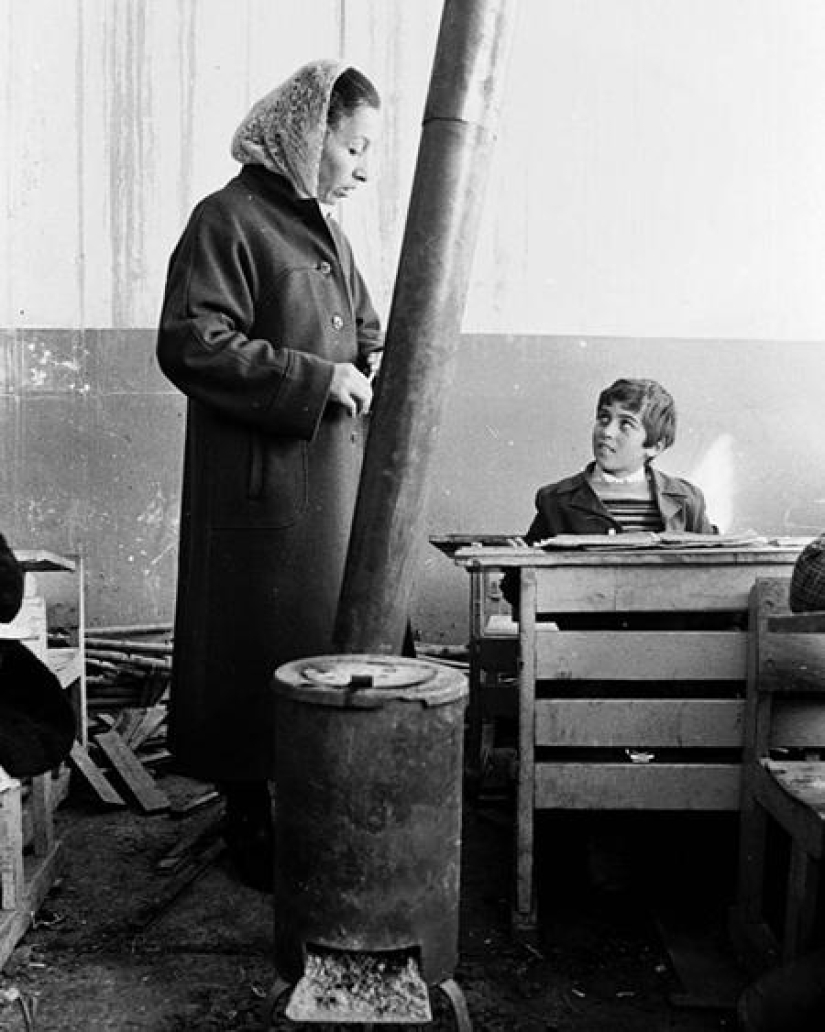 A lesson in an unheated school
A lesson in an unheated school
But Armenians would not be Armenians if they did not find original solutions to problems even in this critical situation. Those who lived at the junction of two neighborhoods that receive electricity at different hours spent themselves "left light" — in other words, stretched an electric cable through trees and poles from an apartment in a neighboring house to their own. Thus, it was possible to have two whole hours instead of one, although having previously turned off the plugs in your apartment so as not to cause a short circuit. The basics of electrical circuits, the dependence of current strength and voltage on resistance, methods for determining "phase" and "zero" — in a matter of weeks, everyone in Armenia has mastered this course of knowledge — from children to the elderly.
The "left light" was also carried out from other sources — from working factories and workshops, from the subway and even from... traffic lights! Which often led to accidents, accidents and fires. Electricians silently and stubbornly fought with the "left light", cutting wires with scissors on a long pole. After a couple of days, the "place of the cliff" was restored again — until the next round of the electrician, who in Armenia was called pathetically and even somehow divinely - "luisi mard" (man of light).
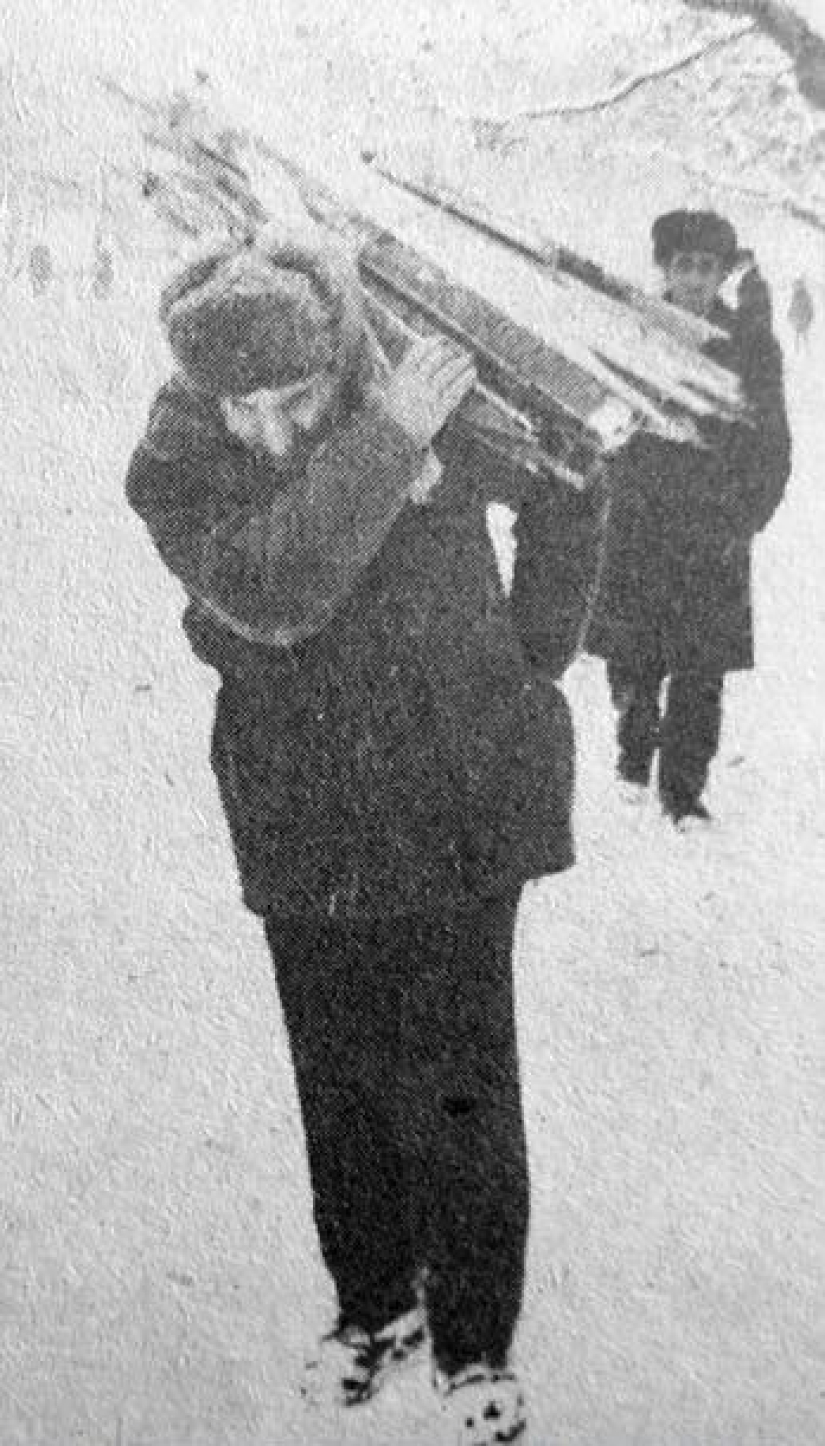 Car owners found their solution to the "dark problem" — they moved car batteries into apartments and, attaching thin wires to them, hung tiny 12-volt light bulbs at the "strategic" points of the apartment — bathroom, toilet, living room. And during the holidays, a whole garland of such bulbs was hung on the "dead" chandelier. Electronics engineers of Armenia assembled numerous modifications of chargers in artisanal conditions — during the hour when there is electricity, the car battery had to be charged at home.
Car owners found their solution to the "dark problem" — they moved car batteries into apartments and, attaching thin wires to them, hung tiny 12-volt light bulbs at the "strategic" points of the apartment — bathroom, toilet, living room. And during the holidays, a whole garland of such bulbs was hung on the "dead" chandelier. Electronics engineers of Armenia assembled numerous modifications of chargers in artisanal conditions — during the hour when there is electricity, the car battery had to be charged at home.
Some particularly nimble people had huge batteries from electric locomotives in their apartments — they took up a lot of space and were incredibly heavy, but their charge was enough for a long time. An excellent purchase was considered to be a muscle-powered pocket flashlight "beetle", so named for the characteristic sound when pressing the dynamo pedal. Portable televisions operating from 12 volts could be safely equated with small deities — every evening in the apartments where they were available, all neighbors reverently sat down at 10-15-centimeter black-and-white screens to find out the latest news and ... watch the next episode of Santa Barbara.
Timid attempts by men to watch something else were decisively suppressed by women, of whom the vast majority had screens: "The battery will run out soon, it's necessary to find out the continuation!" Those who were lucky enough to watch the next series retold it to acquaintances deprived of this opportunity. The American authors of the series, without realizing it, created a certain time axis for Armenia, immersed in darkness — in the "dark years", in this protracted "groundhog day", the flight of time was felt only thanks to primitive intrigues between the heroes of the TV series. But batteries, "left light", and even more so gasoline engines were available only to a few. Most of the population of Armenia has lived these endless 3 years in total darkness.
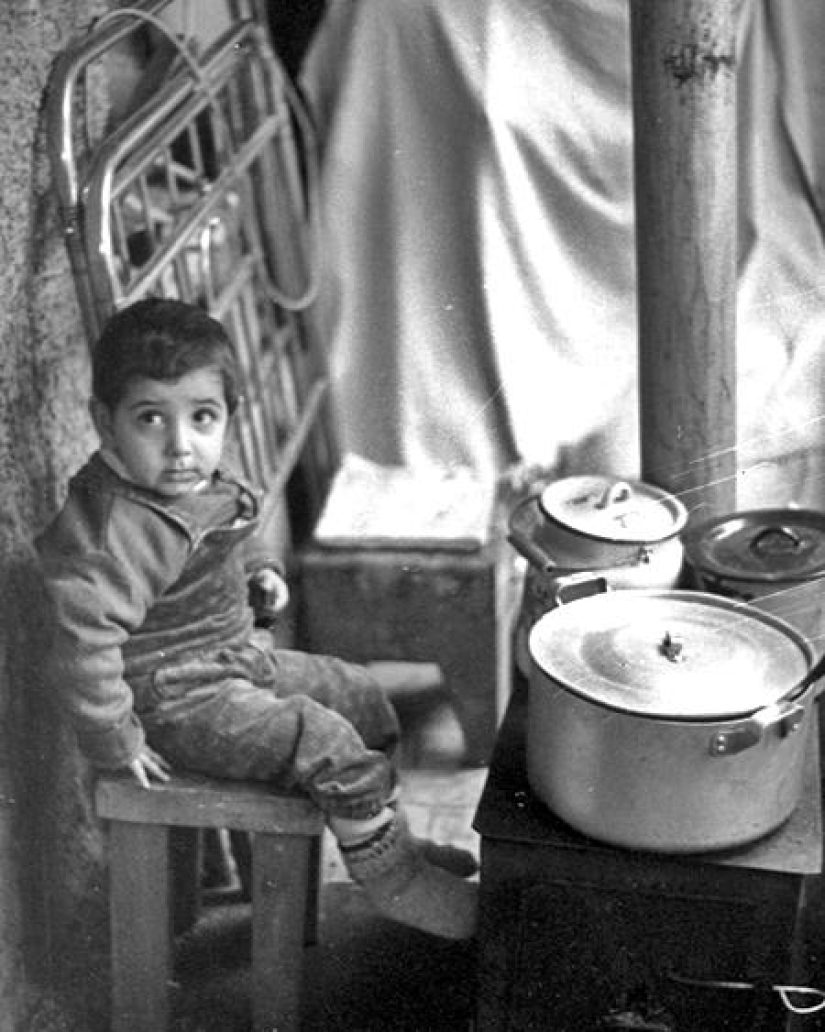 Due to the lack of electricity and gas, another problem has become acute - cooking. How to cook food? People rushed to get wood-burning stoves and kerogas (a small camping device running on kerosene or diesel fuel).
Due to the lack of electricity and gas, another problem has become acute - cooking. How to cook food? People rushed to get wood-burning stoves and kerogas (a small camping device running on kerosene or diesel fuel).
The few factories that were still working had electricity. The women who worked there carried groceries to work in order to cook dinner at home on homemade electric heaters powered by three-phase current. A workshop for the production of electronic products, in the middle of which there is a meter—long piece of asbestos pipe with a thick red—hot spiral wound on it, and on all this - pots with dinners - a common picture of that time. A couple of potatoes could be stuffed into the pipe and baked for lunch. But it had to be done carefully and carefully — high voltage… The results of the "production cooking" were then manually delivered to homes. But only a few worked at the factories… The rest had it worse — coffee was brewed on a candle flame, water for tea was boiled the same way, but you can't boil a pot of soup on a candle — stoves were needed, and they had to be heated with something…
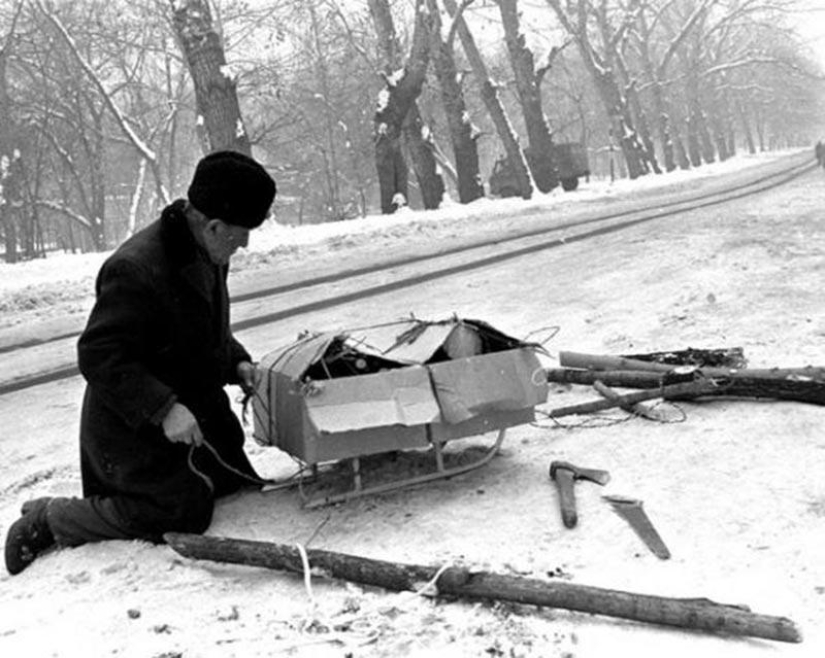
The winter of 1992-1993 came as a large-scale natural disaster. Steam heating batteries showed no signs of life, and electric and gas heaters were useless due to the lack of electricity and gas. Winter that year turned out to be especially cold, the temperature did not rise above minus 25 degrees for a long time. In unheated apartments, water froze in flower vases and buckets, and water pipes and sewers froze in buildings. Surreal picture — residents of Yerevan high—rise buildings, walking down the stairs (elevators did not work), met a man with a torch on each floor, who warmed up a frozen sewer pipe - otherwise all this "good" threatened to spill out into the apartments… Each floor assigned a duty officer with such a torch, from which there was a useful side effect — the pitch darkness of the entrance was illuminated for a while.
Lonely old people began to die in icy apartments... The cold became a real threat to people's lives, and only fire could fight it in such conditions. How and from what to get a fire in an ordinary Yerevan apartment?
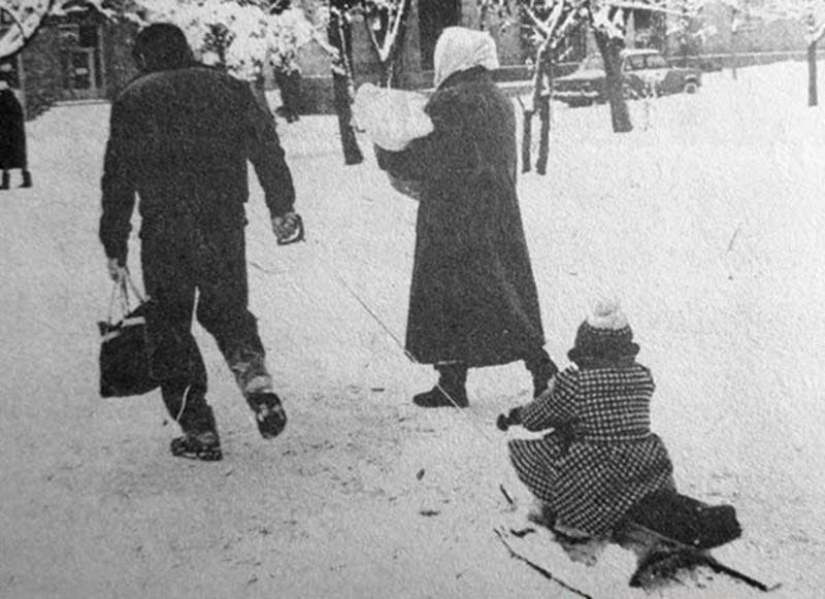 Some kerosene was sometimes given out as humanitarian aid to particularly unsecured segments of the population, but this was only enough to refuel kerogaz, which would not particularly warm. The others had only one choice — a wood-burning stove. It was not easy to get such a stove in a modern city, and it was almost impossible to provide it with fuel, because no one had stored firewood for a city of one and a half million. And Yerevan began to burn in the stoves…
Some kerosene was sometimes given out as humanitarian aid to particularly unsecured segments of the population, but this was only enough to refuel kerogaz, which would not particularly warm. The others had only one choice — a wood-burning stove. It was not easy to get such a stove in a modern city, and it was almost impossible to provide it with fuel, because no one had stored firewood for a city of one and a half million. And Yerevan began to burn in the stoves…
During the "dark years", forests from the hills surrounding the city, parks, squares, alleys on the streets, orchards burned to the ground in Yerevan apartments… Everything in the world was classified then only on one basis — burning or not. All railings, doors, windows and window frames of building entrances were burned. Furniture, parquet, children's cubes, shoes, magazines, books were on fire… The publications of the founders of Marxism-Leninism and the materials of the CPSU congresses burned magnificently. Lenin became relevant again — a couple of volumes with the thoughts of the Bolshevik leader were enough to warm up the soup. Wood-burning stoves carried out an ideological purge of Yerevan's home libraries, leaving only what was really dear to the heart.
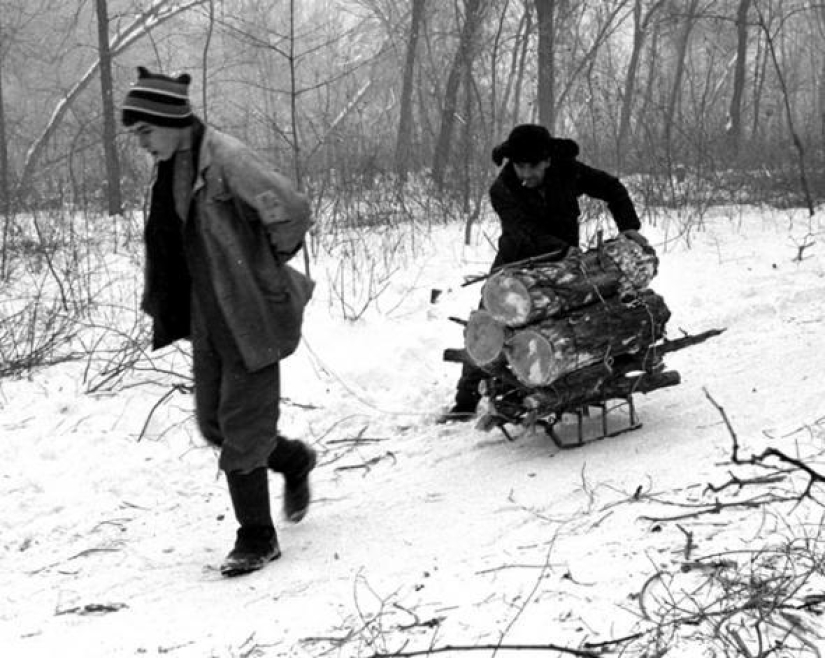 But even the mass destruction of books and trees was not able to provide a continuous fire in the stoves. Have you tried sleeping at home at an air temperature of 0 degrees? To go to bed, I had to... dress warmly. Three layers of clothes, a hat, several pairs of socks, more blankets — this was how they laid down to sleep in Yerevan. Not occasionally and not sporadically, but daily, for 3-4 months a year. The water warmed up in the evening was poured into bottles, which were used as hot water bottles in bed. In the morning, they washed with the same water — the water of the "blanket" temperature was nicer than ice water from the tap. The word "bathe" began to belong to the category of rare solemn rites, which were prepared for a long time and prudently.
But even the mass destruction of books and trees was not able to provide a continuous fire in the stoves. Have you tried sleeping at home at an air temperature of 0 degrees? To go to bed, I had to... dress warmly. Three layers of clothes, a hat, several pairs of socks, more blankets — this was how they laid down to sleep in Yerevan. Not occasionally and not sporadically, but daily, for 3-4 months a year. The water warmed up in the evening was poured into bottles, which were used as hot water bottles in bed. In the morning, they washed with the same water — the water of the "blanket" temperature was nicer than ice water from the tap. The word "bathe" began to belong to the category of rare solemn rites, which were prepared for a long time and prudently.
The bathing schedule in families was strict, cleanliness and personal hygiene were only on a first—come, first-served basis. An inaccessible and distant dream of the absolute majority of Armenians was to "bathe with two hands", that is, standing under the shower and not holding the hated bucket of warm water in his hand.
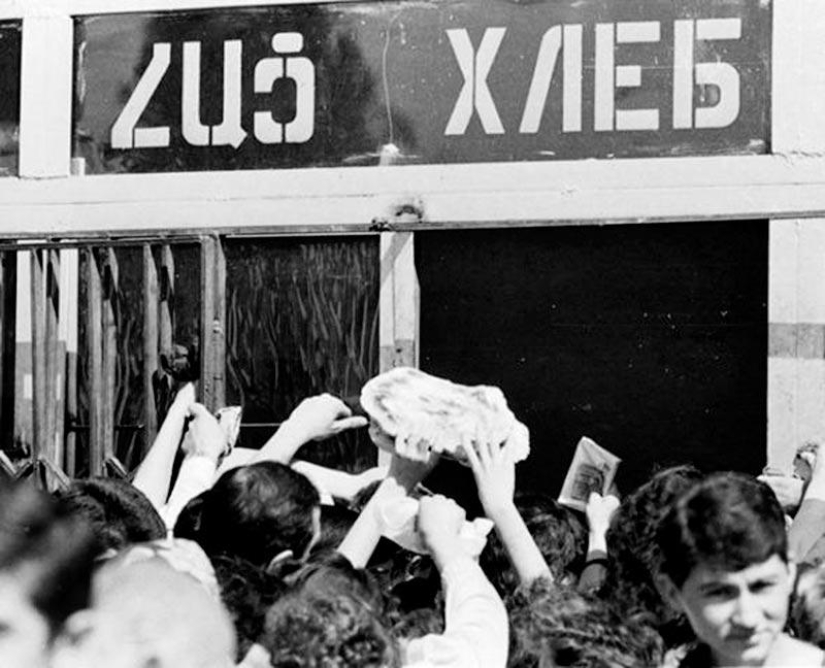
Along with the severe energy crisis, the problem of bread also arose. Grain was delivered to Armenia intermittently, bread cards were introduced — 200 grams per day per person. For comparison, in besieged Leningrad, the norm of bread was 350 grams per day for workers of military factories, 250 grams for workers and 150 grams for children and dependents. After the military reports from Karabakh, the main news was the number of grain wagons that arrived in Yerevan. Despite the cards, there was still not enough bread, we had to stand in queues at the shops for days. The bread itself was often made from a mixture of flour and some inedible "food" additives that gave it a greenish tint and an unpleasant smell. The normal supply of bread was carried out only for the army fighting at the front, while the rest got out as best they could.
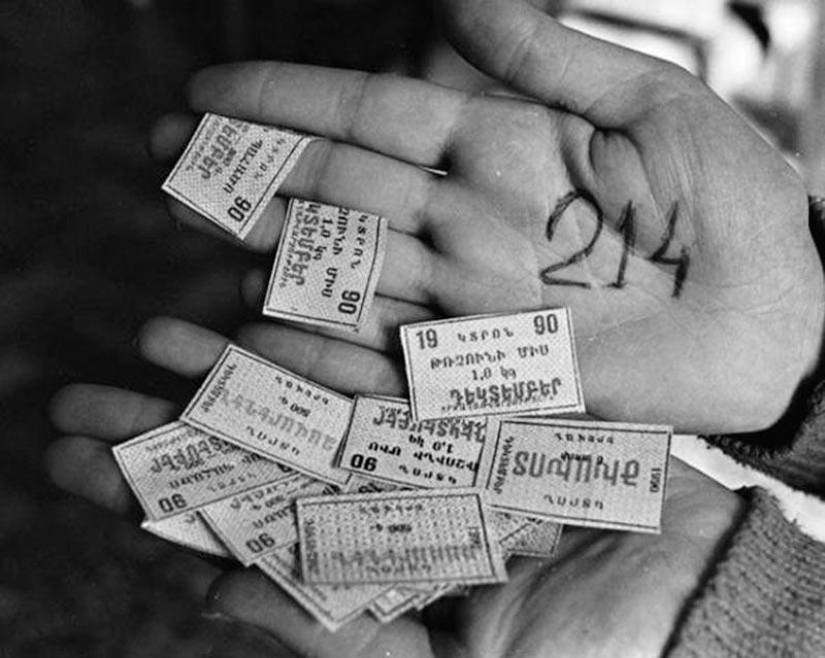 Food cards and a number in the bread queue
Food cards and a number in the bread queue
Products such as eggs, cheese, meat, sausage, became rare and cost prohibitively expensive. Considering that the majority of the population has lost their jobs and, accordingly, earnings, many families are really threatened with hunger. The standard "break" of an employee of a Yerevan enterprise of those years was a piece of bread with jam thinly spread on it (stocks of the previous winter) or a small piece of cheese... Armenia was rescued by Sevan whitefish and cheap eggplants, from which they learned to cook any dishes that were rolled into jars for the winter, dried, pickled… By the way, many "eggplant syndrome" has been preserved — to this day in many families, eggplants are preserved in unjustified quantities for the winter.
Another "lifeline" was relatives living in In Russia and the near abroad, by hook or by crook, they sent money and small parcels with products to their loved ones (due to problems with air traffic).
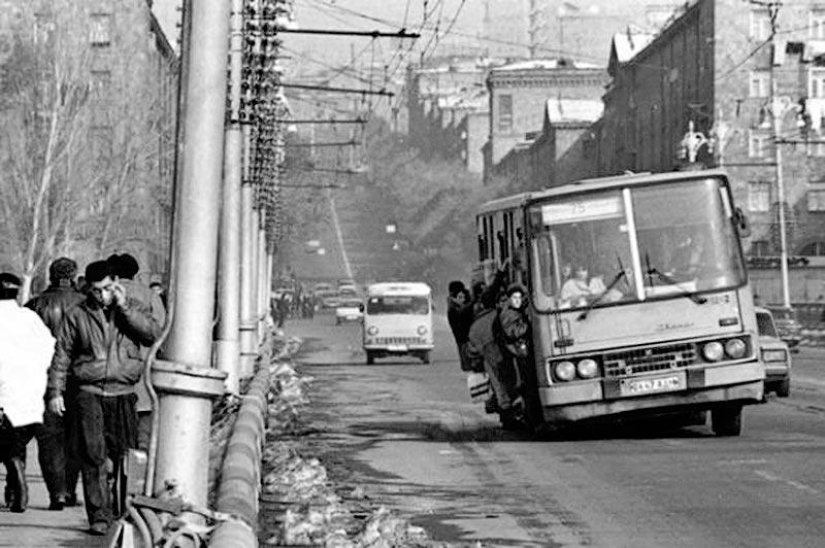
A special trouble of the "dark years" was the connection. Due to the lack of electricity, the PBX stopped working, and the phone as a means of communication was completely forgotten for a couple of years. Phones sometimes spontaneously turned on, any call was like from the other world. For emergencies, there was one (!) working phone in each microdistrict, usually in the housing department. You could go there to call an ambulance or a fire brigade. And if you had to find out how your relatives and friends are doing, then I'm sorry — you just have to go to them and find out. It is necessary to go, because public transport existed only in the bright memory of the citizens.
Rare buses were hung with bunches of passengers and resembled sinking ships. Some trolleybuses made timid attempts to get on the route, but inevitably stood idle for hours during power outages. But in Yerevan, with its large height differences and from these frozen ghosts of civilization, there was a sense — if you push the trolleybus to the nearest descent, then you can jump into it and drive as much as 3-4 stops at idle. Naturally, without stopping. Then — again on foot. And we walked for 10-15 kilometers.
A typical picture of that time is a long line of people wandering along a deserted highway. We went on foot to work, to visit (and what about without it!). The car became a luxury again for a while. And in the evening, pedestrians were attacked by huge packs of stray dogs — hunger drove them too. Rats, which multiplied in huge numbers, became the rightful owners in the city. Now, years later, it is even difficult to understand — what did they eat?
But even in such terrible conditions, strong national Armenian traits — the desire for communication, a sense of humor, mutual support - were clearly manifested. In icy dark apartments, neighbors gathered together to pass the long evenings over endless backgammon games and retelling the latest news. We dined together, read, saw off to war, raised children, joked, sang songs and even danced…
A person is able to withstand a lot. And the Armenians eventually survived. However, not all of them. Since 1992, a mass exodus from the country began — people left anywhere, anywhere in the world, just to survive, just not to freeze, just to put children and the elderly in human conditions. And it is difficult to blame them for this… The planes leaving Yerevan resembled a crowded trolleybus — they flew standing up. The cost of a two-room apartment in the center of Yerevan was then no more than a couple thousand dollars, many still remember the ads on the windows and balconies of buildings: "I'm changing the apartment for a ticket." According to various estimates, more than a million people have left Armenia during the "dark years". Yerevan is literally deserted.
Looking at Yerevan today, at the people of Yerevan, it is hard to believe that many of them have gone through all this together — cold, hunger and darkness. The nightmare is in the past, which no one likes to remember today. But hundreds of thousands of felled trees remind us of hundreds of thousands who left. They left together —trees and people. The strongest ones remained. And roots. So life goes on.
Text: Eduard Ayanian / Photo: Photolure
Recent articles

Treasures are all associated with pirates, robbers and the affairs of bygone days. You will be surprised, but countless treasures ...

Professional street photographer Eric Kim teaches his craft in workshops around the world. Next, you will find some tips from a ...

An Englishman, a German and a Russian meet... No, this is not the beginning of another joke, but a rough description of a video ...